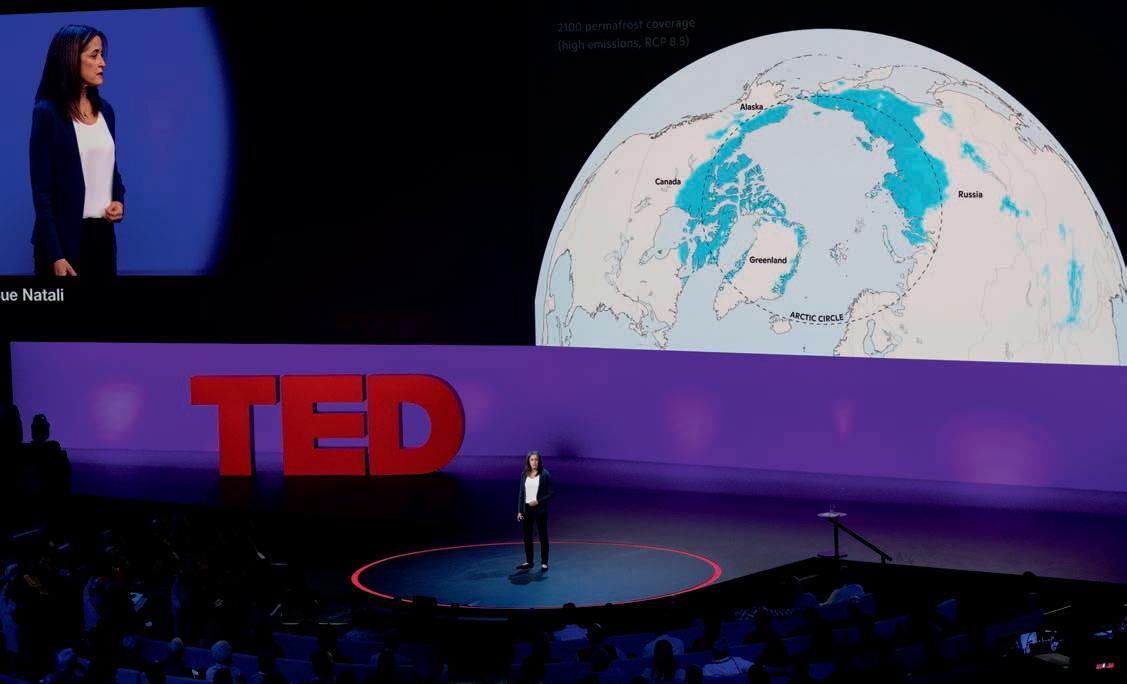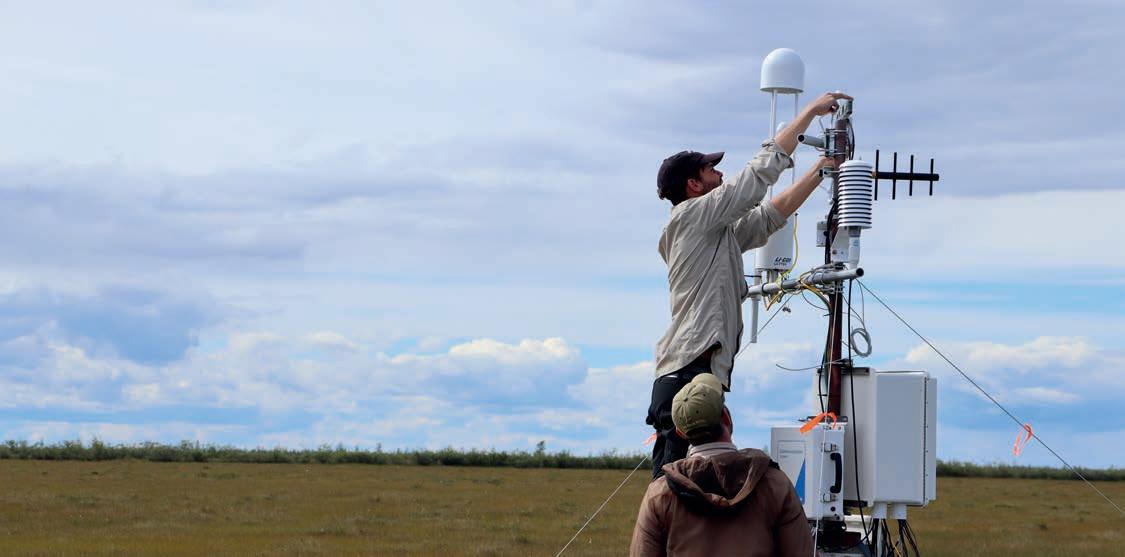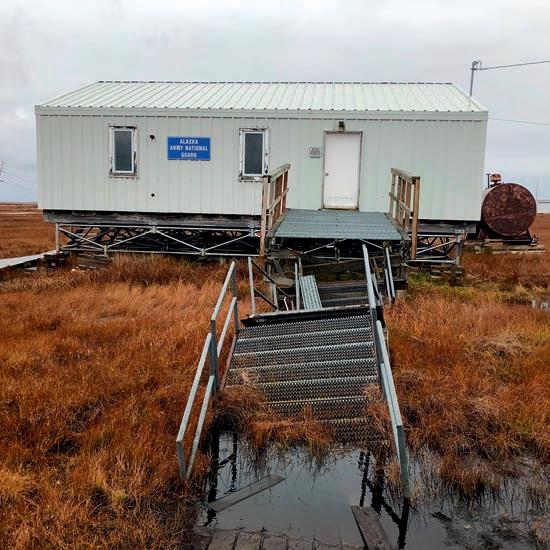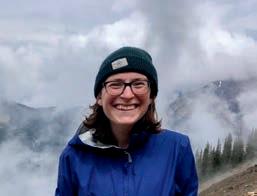
5 minute read
The Arctic Initiative Launches New Permafrost Pathways Project
Dr. Sue Natali, Arctic Program Director and Senior Scientist at Woodwell Climate Research Center, announced the launch of Permafrost Pathways during a TED Talk in April 2022.
Multi-Year Collaboration Aims to Better Understand, Mitigate, and Adapt to Major Arctic Threat
In April, the Arctic Initiative, in collaboration with the Woodwell Climate Research Center and the Alaska Institute for Justice, announced the launch of Permafrost Pathways: Connecting Science, People, and Policy for Arctic Justice and Global Climate. A six-year, $41 million initiative catalyzed through The Audacious Project, this effort brings together leading experts in Arctic climate science, policy action, and environmental justice to inform and develop adaptation and mitigation strategies that address the local and global impacts of Arctic permafrost thaw.
Filling the Gaps in Permafrost Science
Greenhouse gas emissions from thawing permafrost—perennially frozen ground that covers 15% of the Northern Hemisphere land area—are one of the biggest areas of uncertainty in global climate calculations. Thawing permafrost is expected to release between 30 and 150 billion tons of carbon by 2100; by the end of this century, these emissions may be as large or larger than the emissions from the United States over the same period at its current rate. Yet, due to uncertainties about the size and timing of these emissions, permafrost is largely overlooked in today’s international climate policy. “Because we can’t put a precise number on permafrost emissions, policymakers are essentially excluding them, setting global emissions targets that are wholly insufficient to protect us from catastrophic climate change,” said Sue Natali, Director of the Arctic Program at Woodwell. Unless these emissions are properly accounted for in setting emissions targets, the 2° Celsius global temperature threshold established in the Paris Agreement could become unattainable. In order to develop more complete data on permafrost emissions, the scientific team at Woodwell will coordinate a pan-Arctic carbon monitoring network and modeling initiative to improve the ability to track and forecast permafrost thaw and resulting carbon emissions. “We’re working with an international team of Arctic scientists to strategically identify and fill carbon monitoring gaps by upgrading and installing new equipment to monitor greenhouse gases across the entire Arctic,” explained Natali during a public panel about the project in June. “We will then use this data to build the first ever data assimilation model for Arctic carbon cycling. This state-of-the-art modeling approach will allow us to accurately project permafrost emissions now and into the future.”

Woodwell’s Dr. Kyle Arndt and Patrick Murphy installing an eddy covariance flux tower in Churchill, Manitoba, Canada — the inaugural new tower of the Permafrost Pathways project.
Locally, permafrost thaw results in erosion and subsidence, causing buildings to crack, roads to collapse, and pipelines to fail.
Keeping Global Climate Goals Within Reach
Doing the science is only half the battle: the project’s research must also be delivered into the hands of those poised to decide how we deal with the warming Arctic. “Decisions are being made across the planet—about policy, investment, individual purchases, industry, energy—that are driving rapid permafrost thaw, which is subsequently worsening climate impacts and disasters around the world,” said Arctic Initiative Senior Fellow Fran Ulmer during the June panel. “We need to ensure policymakers are sufficiently confident about the contribution of permafrost thaw to climate change, so that they can make informed decisions about what kind of mitigation actions are necessary.” Armed with updated data and models from Woodwell, the Arctic Initiative will help lead efforts to elevate the topic of Arctic permafrost thaw in international climate dialogues, supplying key national and international policymakers with the information necessary to accurately incorporate permafrost emissions projections into climate mitigation policy.

“The solution to the problem of rapid climate change in the Arctic has to be, above all, acceleration of the effort to reduce global emissions of greenhouse gases from the combustion of fossil fuels and land use change. In the region, of course, any sense of common humanity with the people who have to live with these dramatic transformations in the Arctic would also dictate that the rest of the world pay attention and do its part to diminish the fundamental driving force that is causing these problems.” —John Holdren, from “A Sleeping Giant: Why Permafrost is a Climate Threat,” on The Agenda with Steve Paikin
Building Resilience in Arctic Communities
Even with the most ambitious climate action, a rapidly warming Arctic has already led to permafrost thaw which threatens communities. Across the Arctic, erosion and subsidence caused by melting permafrost are having devastating impacts on Northern infrastructure, landscapes, livelihoods, and traditional ways of life. “Communities in the Arctic are already confronting impossible decisions about where and how they can live in the face of life-threatening impacts of permafrost thaw,” said Robin Bronen, Executive Director at the Alaska Institute for Justice (AIJ). AIJ, in collaboration with the Alaska Native Science Commission, is working on the ground in Alaska with environmentally threatened communities, to monitor the ways permafrost thaw is impacting daily lives and better understand community priorities related to policy pathways to address these climate risks. Drawing on the resilience policy expertise within the Arctic Initiative, this project will co-create equitable, community-driven adaptation strategies and advance a just governance framework to ensure Arctic residents have the resources necessary to confront hazards stemming from climate change. Also germane to the community resilience prong of Permafrost Pathways is the Initiative’s work on Arctic infrastructure challenges in a changing climate, led by Co-Director Henry Lee, and on building adaptation capacity and public healthcare in Arctic communities, led by Senior Fellows Joel Clement and Jennifer Spence and Faculty Associate Stuart Harris. “It’s critical that we support the communities on the frontlines of climate change,” said Arctic Initiative Senior Fellow Joel Clement. “Not only so they have the necessary resources, but also so they have a say in international climate policy discussions that directly affect them.”
Next Steps
In September 2022, the Arctic Initiative will host the first policy convening for the Permafrost Pathways Project at Harvard Kennedy School. The meeting will provide an opportunity for the invitees to learn about the project, to offer their thoughts about the challenges and opportunities at the intersection of permafrost science and policy, and to consider the possibilities for connecting their own Arctic projects and responsibilities with the Permafrost Pathways effort.
“Climate change in the Arctic is affecting what happens at lower latitudes. In climate journalism, it’s a truism that people think climate change is just about polar bears. I think sometimes that makes journalists want to write about impacts that are happening in places where most people live. The Arctic is obviously not as densely populated as the mid latitudes, but what happens in the Arctic doesn’t stay there.” —Climate journalist Sarah Kaplan on the global impact of Arctic warming, from “Doomsday to Hope:
Changing the Climate Crisis Narrative,” a seminar organized by Senior Fellow Cristine Russell

Learn more at permafrost.woodwell.org.










